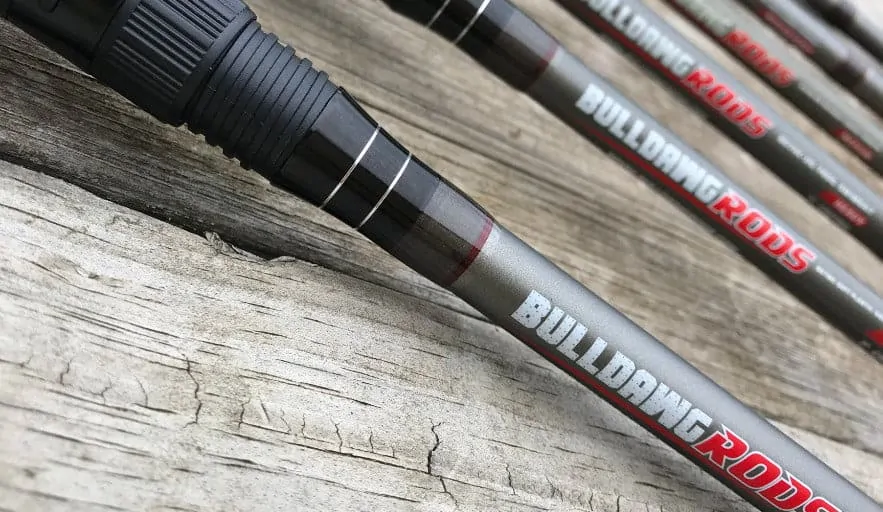
Heavy, medium heavy, medium, and light power rods all have different uses with varying backbone, strength, and action
Freshwater vs. Saltwater fishing rods
Saltwater rods and reels are designed to withstand the corrosion of sea salt, primarily through stainless steel components.
Because saltwater rods also are heftier and thicker, some freshwater fishermen prefer saltwater rods for their extra strength when luring large predators or catfish fishing. This heft will be too much for delicate catches like panfish or ice fishing.
If you only occasionally or never go fishing in the ocean, stick to freshwater rods. You’ll have more options in line and weight strength. If you take a freshwater rod to the sea, rinse it thoroughly with fresh water as soon as you’re done.
Graphite vs. Fiberglass and Carbon Fiber rods
Fishing rods come in graphite or fiberglass. Graphite rods are best for more sensitive fishing scenarios because of their stiffness. If you’re using live bait or working jigs that requires feeling subtle bites or twitching, use graphite. All of the Bulldawg Rods series are graphite rods, meaning you get more sensitivity and feeling from the rod and lure.
Crankbaits like the Backstabber Crankbait and jerkbaits like the Reaction Strike XRM benefit from those differences in sensitivity. It can mean the difference between a fish that gets away and a solid hookset. Rods like the Bulldawg Rods Predator Series can take a bend and stay bent while you’re reeling in a large predator.
The Backstabber Crankbait is a good choice for beginning and experienced anglers. It has a one-of-a-kind design with a hook on the tail and back, doubling your chances for a successful hookset.
Parts of a fishing rod

Rods have five main parts.
- The butt cap is the part most fishermen end up shoving into their stomachs for extra leverage.
- The handle, which is usually made of cork or foam. All Bulldawg Rods have cork handles, which are easier to repair if you find cracks. Just add glue to patch them up. Foam handles are impossible to repair.
- The butt of the rod is the thickest portion just above the handle. Good rods have handles easy to hold on to without slipping.
- The reel seat, which is where the reel attaches to the rod.
- Guides are the small eyelets along the rod where the line is held.
One-piece vs. multi-piece rods
Rods are one, two, or multi-piece, with the most common being one or two. One-piece is stronger, more durable, and more sensitive. Two-piece and multi-piece rods bring convenience in transport because they can fit in the back of a car or truck easier. All Bulldawg Rods are one-piece, which improves durability by reducing the number of failure points.
Spinning, Spin Casting, and Bait Casting
Spinning, spin casting, and bait casting are terms closely associated with the reel and line. Broadly, spinning rods are easy to cast and the rods are lightweight. Spin casting rods are also easy to throw because the lure will cast itself out with ease, but these lack gear systems that hold catches when hooked. But because they lack gears, their simplicity means they last longer.
Bait casting rods are best for heavy fish. They use thicker, heavier line and require thicker, heavier rods for sturdier hooksets. Their stability reduces micro-vibrations caused by talking or your hand movement, which can help catch smarter predators.
Rod action, power, and fast or slow tips

Pros often describe rods as having a “Fast tip” or “slow tip”. This refers to the angle the rods bend. Fast tip means the rod is bending at the top. Slow tip means it’s bending from the base to the end of the tip in one smooth, curved movement. You want a fast tip with live baits and slow tips for crankbaits, swimbaits, and jerkbaits.
Rod action is so essential that most rods list their action style right on the handle or rod. Action refers to the rod’s flex when under strain and Power refers to the rod’s resistance when being flexed. Rods are labeled medium, medium-heavy, light action, or heavy power. These variants also include fast action and slow action.
If you only have one choice available to you, go with a medium power rod. Medium power will cover the fullest possibilities in fresh and saltwater environments.
The fast or slow action describes how quickly the rod will pull back when you apply force. Fast action is useful for big, strong predators in deep water. Using a fast action rod in small or shallow waters will prove frustrating for catching anything but weeds and driftwood.
Slow action rods work well with short casts and small fish. They’re highly accurate because of their short cast distance but are susceptible to blowing in windy conditions.
As the names suggest, light power and fast action are for lightweight fish, like panfish, bluegill, crappie, and small trout. Light action rods lack stiffness and backbone that’s necessary for heftier catches like bass, sea bass, catfish, trout and walleye. For those, you’ll need a rod with more stiffness so you can lock the hook in with a solid twitch of your wrists.
- Light rods handle lures that weigh under 1/16 ounce.
- Medium rods work best with lures around 1/8–3/8 ounces, and
- Medium-heavy and Heavy rods handle line over 4lb Test and lures between 3/16–1 1/2 ounces.
If you use a rod that is too heavy for the species you’re fishing the rod will be too strong for the fish and can lose your bait or yank away from the fish.
For larger black bass, walleye, catfish, and others, a medium power with moderate-fast or fast action rod works well. Largemouth bass, striped bass, and other large predators will need a medium heavy or heavy power rod with fast action coupled with swimbaits like the Castaic Jerky J or Reaction Strike Fathead Jr.

6 tips for maintaining and storing your fishing rod
- Wash your rod and reel with fresh water or a combination of vinegar and fresh water after each use. This will keep it from rusting, discoloring, or developing an odor.
- Always secure your rod when transporting your rod in a boat or vehicle. The eyelets are the most vulnerable component of the rod.
- Remove the line before storing your rod.
- Don’t lean the rod against a wall or shelf. It will bend as temperatures change in a basement or garage and stay bent.
- Use glue to repair cracked cork handles and sand any guides if they begin to crack or chip. Sanding the guides keeps them smooth so they don’t accidentally cut your line later.
- A toothbrush is a great way to brush away dirt and sand from crevices quickly.






[…] thing to remember is to avoid using rods that are too stiff. A rod with more flexibility prevents you from pulling lures away from […]